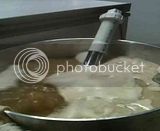kpr121
Well-Known Member
I was using my 1500w element to warm up a mash. Some of the grain must have gotten stuck in it because after about a minute of stirring I started smelling and seeing smoke come out of the mash. I turned of the stick and pulled it out of the mash. It was glowing red-hot. After it cooled down I turned it back on and it started tripping the GFI. I started inspecting the element and noticed that it had cracked and that the metal had become really soft. I bent it with my hands.
Since I used JBWeld, I pretty much have to scrap this one. I'd like to find a way to make one so that the element can be reasonably easy to remove and replace. I may try silicone.
I had a similar issue this weekend, but with my HLT. I have an element installed through the kettle wall, but needed to really goop the JBWeld to ensure that there was no leak. When it was time to turn on the pond pump for IC chilling, I accidently plugged in the element instead. Well there was no water in the HLT at the time, and I didnt notice until I heard a crackle and smelled the burning. I was disgusted in my idiocrocy, and havent really looked at it in detail yet (still mourning), but I do know that the GFCI trips everytime I plug it in, so it is toast. Maybe this time I will install it a bit more cleanly through the kettle wall.
I also thought about capping the hole in the kettle and building a heatstick that can be used in a variety of ways for brewing, not just in the hlt. We shall see.







